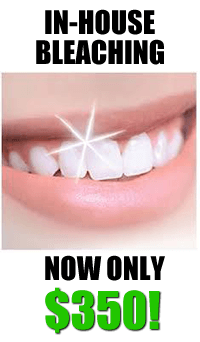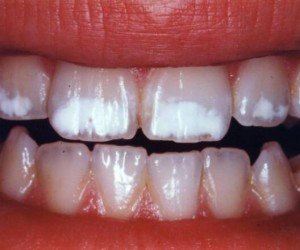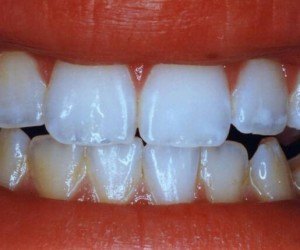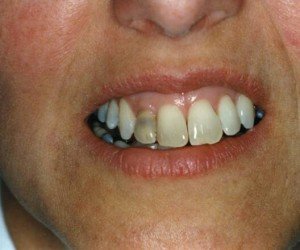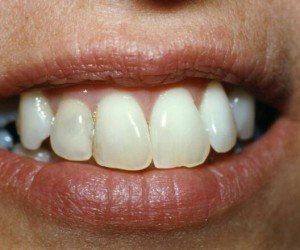Teeth Bleaching
How do Bleaching products actually whiten teeth?
All bleaching (whitening) products that are available either in stores or in dental offices, which are considered effective and safe contain the same active ingredients, either hydrogen peroxide or carbomide peroxide.
Carbomide peroxide transforms into hydrogen peroxide, which lightens the darker pigments on and in the surface of teeth. The longer the hydrogen peroxide stays in contact with the pigments the lighter they become.
What is the difference between bleaching with over-the-counter (OTC) products, whitening trays, and in-office techniques?
The differences between these techniques relate to the strength of their active ingredients, and the ways they are delivered and protected from moisture (such as saliva) that can inactivate them.
Over the counter products contain lower concentrations of the active ingredient. The whitening gels that are placed in trays usually contain moderate concentrations, and the in-office bleaches contain higher concentrations. OTC whitening products are packaged as rinses or drops that can be painted on teeth or as adhesive strips. The strips, which resemble little band aids can be attached directly to the front surfaces of teeth.
Whitening tray and in-office bleaches are gels because they are sticky and tend not to run off of teeth.
Hydrogen peroxide can NOT lighten teeth if it becomes contaminated (touched) by water or saliva. Thus whitening drops lose their effectiveness once they touch a lip or tongue. Whitening strips are covered with a thin barrier that delays the time it takes moisture to flow into contact with teeth. However, saliva can ooze between the strip and teeth quickly. A whitening tray is a soft plastic that can wrap around all of the upper or lower teeth. It can be purchased OTC or custom made by a dental office using models made from a mold of the teeth. A whitening gel can then be painted into the tray and the tray inserted over the teeth. OTC trays typically come in only one size and shape, and therefore fit teeth loosely. Dental office trays are less likely to allow moisture to flow in or bleach to flow out than OTC trays because they are custom fitted to the teeth. Prior to in-office whitening dental assistants place barriers around the cheeks, gums, and lips to separate them from the bleach. These barriers and saliva vacuuming straws help keep moisture away from the teeth, and permit the bleach to sit on the teeth longer than with other methods.
Before Whitening
Below are photos showing before and after teeth bleaching.
How do the special laser whitening systems work and can they lighten teeth more than other techniques?
Some bleaches need a laser, heat, or light to activate the gel. Independently conducted comparison studies do NOT show any increased whitening or faster results with laser or light activated systems.
Is tooth whitening painful?
All bleaching materials can cause sensitivity in both the gums and teeth. As the percentage of peroxide rises the chance of gum sensitivity increases. Hydrogen and carbomide peroxide in lower concentrations used by OTC products may cause gum “tingling” similar to the feeling that some people feel after eating a grapefruit or orange. The higher concentrations used in bleaching trays can cause more irritation. And the percentages used during in-office bleaching can instantly burn the gums and cause ulcers, which can take as long as week to heal. Thus high concentration bleaches can not be used as rinses, drops, strips or in whitening trays.
Bleaching can also cause tooth sensitivity in some people, but it does not appear to be related to the percentage of peroxide. Lower concentrations can cause as much tooth pain as higher ones. The outer layer of a tooth is made of enamel, the outer layer of a root is made of cementum, and the middle layer of each is made of dentin. The pigments that respond to peroxide are located in enamel. Peroxide contact with cementum or dentin produces little whitening, yet it frequently induces pain. It is impossible to prevent OTC and whitening tray bleaches from flowing off of enamel onto other teeth surfaces: therefore, they can produce more tooth sensitivity that in-office bleaches. The bleaches that are most effective and least irritating only touch enamel.
How long does it take to whiten teeth with each technique?
Higher concentrations do NOT whiten more than lower concentration, they just work faster. The longer the whitening product remains in contact with teeth the better they will whiten. The longer the whitening product stays uncontaminated by saliva and other chemicals the longer it will lighten. As soon as it mixes with any other liquid it stops working.
The in-office techniques tend to whiten better simply because dental professionals can prevent contact between fluids and the bleach and enable more time for the bleach to stay in contact with the teeth. For some people a single one to two hour session can produce pleasing results.
Comparable whitening with bleaching trays can take from 1-8 weeks. Comparable whitening with OTC products may not be possible because the bleaches may not stay pure long enough to produce significant whitening. In some instances OTC products will produce good results in 4-12 weeks.
Which color teeth respond the best to Bleaching?
The yellow areas seem to respond the best. Brown ones respond almost as well. Grey areas are less likely to lighten and blue stains are the least responsive.
If one tooth is darker than the other teeth can it be lightened?
Yes. Sometimes a tooth will become much redder, browner or grayer than its neighbors. This occurs when the blood vessels within it stop circulating blood. The tooth loses its ability to wash out any dark debris that may get inside of it, and these fragments get into its pores. The tooth’s canals can be cleaned out and sealed (root canal therapy) then a special whitening gel can be placed inside of the tooth. Internal bleaching is inserted from the hidden back side of the tooth so the front of the tooth does not have be altered. Below are photos showing this type of this technique, which is called “internal bleaching”.
If you need immediate care, contact us at 610-906-8882.
24 Hour Emergency Dentist
After Whitening
Before Internal Bleaching
After Internal Bleaching
Will any bleaching products lighten tooth colored fillings?
No. Bleaching will not affect shade of any fillings, bonding, veneers or crowns.
the
How long do the teeth stay whiter after they bleach?
While each person responds differently everyone will experience some degree of relapse. An approximate guide as to what to expect is that bleaching will make your teeth look ten years lighter. At the end of the bleaching your teeth will darken a little bit and return to their pre-bleaching color in 3-4 years. To prevent this relapse from occurring you can periodically re-bleach your teeth. Teeth that relapse to darker shades seem to respond faster to touch-up bleaching sessions than to first bleaching treatment. This can be accomplished by using an OTC bleach for a few days each month, a whitening tray bleach for one hour six times per year, or an in-office session one time per year.
What is the cost for bleaching?
The cost for OTC rinses and drops generally range between $5 and $10, and for the adhesive strips between $20 and $50. The fees for whitening trays is approximately $250 per arch (or $500 for both upper and lower arches). The bleaching trays can be used in the future as long as the size, shape, and position of all the teeth remain constant. If any teeth undergo repair or drift, then the bleach tray may not fit as well. The fee for in-office bleaching is approximately $600 per session.
The fee for OTC touch-up treatments is between $5 and $10. If the bleach trays fit one can also purchase a one-year supply of touch-up bleach for between $5 and $10. The fee for in-office touch-up is approximately $300-$600 per session.
Which technique is the best?
OTC products are most effective in people who have dry mouths (produce little saliva) and those who are able and willing to refrain from talking, eating and drinking for long periods of time. When choosing a bleaching technique consider the amount of time and money you are willing to commit, your tolerance for possible gum or tooth sensitivity, the color of your teeth and the degree to which you want to lighten them.
***


